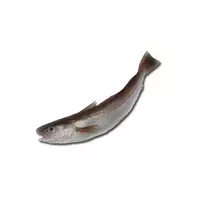Merlang fish

The small merlang commercial fish, which reaches half a meter in length, belongs to the cod family. Its main habitats are the North, Black and Barents Seas, as well as the Mediterranean. The back of the merlang fish is brownish brown with a purple tint, with the sides silvery and the belly and underparts white. In appearance, it closely resembles haddock fish.
In terms of gastronomic qualities, merlang fish does not stand out much, since the meat of this inhabitant of the seas, although quite tasty, is a little dry due to its low fat content. That is why it is remarkably suitable as a dietary food that will enrich the diet of people seeking to lead a healthy lifestyle.
Basically, this sea fish is used both raw and cooked. Seafood connoisseurs argue that merlang fish should not be stored for a long time, so it is better to eat it in the near future, having prepared some kind of nutritious and healthy dish. Often, merlanga is advised to be extinguished with ham or lard, thanks to the fat content of which a little dry fish meat gains juiciness and becomes more tender.
merlang fish 88 kCal
Energy value of merlang fish (Ratio of proteins, fats, carbohydrates - ju):
Proteins: 17.5 (~ 70 kCal)
Fats: 2g (~ 18kCal)
Carbohydrates: 0 g (~ 0 kCal)
Energy ratio (b | y): 80% | 20% | 0%
 Español
Español Français
Français Português
Português Русский
Русский 简体中文
简体中文 繁體中文
繁體中文 日本語
日本語 한국어
한국어 العربية
العربية Türkçe
Türkçe Қазақ
Қазақ Deutsch
Deutsch Italiano
Italiano Українська
Українська
